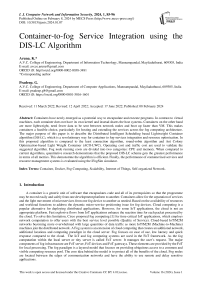Container-to-fog Service Integration using the DIS-LC Algorithm
Автор: Aruna K., Pradeep G.
Журнал: International Journal of Computer Network and Information Security @ijcnis
Статья в выпуске: 1 vol.16, 2024 года.
Бесплатный доступ
Containers have newly emerged as a potential way to encapsulate and execute programs. In contrast to virtual machines, each container does not have its own kernel and instead shares the host systems. Containers on the other hand are more lightweight, need fewer data to be sent between network nodes and boot up faster than VM. This makes containers a feasible choice, particularly for hosting and extending the services across the fog computing architecture. The major purpose of this paper is to describe the Distributed Intelligent Scheduling based Lightweight Container algorithm (DIS-LC), which is a revolutionary way for container to fog-services integration and resource optimization. In this proposed algorithm is compared to the least connection algorithm, round-robin algorithm and Ant Colony Optimization-based Light Weight Container (ACO-LWC). Operating cost and traffic cost are used to validate the suggested algorithm. Fog node running costs are divided into two categories: CPU and memory. When compared to current algorithms, quantitative research demonstrates that the proposed DIS-LC scheme gets the greatest performance in terms of all metrics. This demonstrate the algorithm is efficient. Finally, the performance of containerized services and resource management systems is evaluated using the iFogSim simulator.
Container, Docker, Fog Computing, Scalability, Internet of Things, Self-organized Network
Короткий адрес: https://sciup.org/15018823
IDR: 15018823 | DOI: 10.5815/ijcnis.2024.01.07
Список литературы Container-to-fog Service Integration using the DIS-LC Algorithm
- A. Pires, J.Simao, and L.Veiga, “Distributed and Decentralized Orchestration of Containers on Edge Clouds”, Journal of Grid Computing”, Vol.19, No.3,2021,doi:10.1007/s10723-021-09575-x.
- C.L.Tseng and J.LFuchun, “Extending Scalability of IoT/M2M Platforms with Fog Computing”, in Proc. of the IEEE 4th World Forum on Internet of Things (WF-IoT), Singapore, pp.825-830, 2018.
- W. Wang, Y. Zhao, M. Tornatore, A. Gupta, J. Zhang et al., “Virtual machine placement and workload assignment for mobile edge computing,” in Proc. of the IEEE 6th International Conference on Cloud Networking (CloudNet), Prague, pp. 1–6, 2017.
- A. Ahmed and G. Pierre, “Docker Container Deployment in Fog Computing Infrastructures,” IEEE International Conference on Edge Computing (EDGE), USA, pp. 1-8, 2018, doi: 10.1109/EDGE.2018.00008.
- D.V.Leon, L.Miori, J.Sanin, N.E.Ioini, S.Helmer et al., “A Lightweight Container Middleware for Edge Cloud Architectures,” Fog Edge Computing: Principles and Paradigms, pp. 145–170, 2019.
- E. Yigitoglu, M. Mohamed, L. Liu and H. Ludwig, “Foggy: A Framework for Continuous Automated IoT Application Deployment in Fog Computing,” in Proc. of the IEEE 6th International Conference on AI &Mobile Services (AIMS), USA, pp. 38–45, 2017.
- M.Taneja and A.Davy, “Resource Aware Placement of IoT Application Modules in Fog-cloud Computing Paradigm,” in IFIP/IEEE Symposium on Integrated Network and Service Management (IM), Portugal, pp. 1222–1228, 2017.
- OpenFog Consortium, “OpenFog Reference Architecture for Fog Computing,” 2017.
- P.Hu, S.Dhelim, H.Ning and T.Qiu, “Survey on Fog Computing: Architecture, key Technologies, Applications and Open Issues”, Journal of Network and Computer Applications, Vol. 98, pp.27-42, 2017.
- Maryam Sheikh Sofla, Mostafa Haghi Kashani, Ebrahim Mahdipour and Reza Faghih Mirzaee, “Towards effective offloading mechanisms in fog computing”, Multimedia Tools and Applications, Vol.81, pp.1997–2042, 2022.
- B.David and J.L.Fuchun, “OpenStack-based Highly Scalable IoT/M2M Platforms”, in Proc. of the IEEE International Conference on Internet of Things (iThings), United Kingdom, pp.711-718, 2017.
- H.Gupta, V.D.Amir, K.Soumya and R. Buyya, “iFogSim: A Toolkit for Modeling and Simulation of Resource Management Techniques in the Internet of Things, Edge and Fog Computing Environments”, Software: Practice and Experience, Vol.7, no.9, pp.1-22, 2017.
- M.M.Lopes, M.A.M.Capretz and L.F. Bittencourt, “MyiFogSim: A Simulator for Virtual Machine Migration in Fog Computing”, in Proc. of the 10th International Conference on Utility and Cloud Computing, USA, pp. 47–52, 2017.
- M. Redowan Mahmud and R. Buyya, “Modelling and Simulation of Fog and Edge Computing Environments using iFogSim Toolkit”, Fog and Edge Computing, 2018, DOI:10.1002/9781119525080.CH17.
- R. Mahmud, S. Pallewatta, M.Goudarzi and R.Buyya, “iFogSim2: An Extended iFogSim Simulator for Mobility, Clustering and Microservice Management”, Edge and Fog Computing Environments, 2021.
- https://linuxcontainers.org/lxc/getting-started, 6.04.2022.
- Amina Mseddi, Wael Jaafar, Halima Elbiaze and Wessam Ajib, “Joint Container Placement and Task Provisioning in Dynamic Fog Computing”, IEEE Internet of Things Journal, 2019, doi 10.1109/JIOT.2019.2935056.
- V.Hurbungs, V.Bassoo and T.P. Fowdur, “Fog and edge computing: concepts, tools and focus areas”, International Journal of Information Technology, Vol. 13, No.2, pp.511–522, 2021, doi: 10.1007/s41870-020-00588-5.
- Ahmed M. Alwakeel, “An Overview of Fog Computing and Edge Computing Security and Privacy Issues”, Sensors, Vol. 21, No. 24, pp. 8226, 2021, doi:10.3390/s21248226.
- Abdelaali Chaoub, Aarne Mammela, Pedro Martinez-Julia and Ranganai Chaparadza, “Self-Organizing Networks in the 6G Era:State-of-the-Art, Opportunities, Challenges and Future Trends”, 2021,doi.org/10.48550/arXiv.2112.09769.
- Zainab Javed, Waqas Mahmood, "A Survey Based Study on Fog Computing Awareness", International Journal of Information Technology and Computer Science, Vol.13, No.2, pp.49-62, 2021.
- Mohamed A. Elsharkawey, Hosam E. Refaat, " MLRTS: Multi-Level Real-Time Scheduling Algorithm for Load Balancing in Fog Computing Environment", International Journal of Modern Education and Computer Science, Vol.10, No.2, pp. 1-15, 2018.
- Vishal Kumar, Asif Ali Laghari, Shahid Karim, Muhammad Shakir, Ali Anwar Brohi,"Comparison of Fog Computing & Cloud Computing", International Journal of Mathematical Sciences and Computing, Vol.5, No.1, pp.31-41, 2019.
- H. Gupta, A. V. Dastjerdi, S. K. Ghosh and R. Buyya, “iFogSim: A Toolkit for Modeling and Simulation of Resource Management Techniques in the Internet of Things, Edge and Fog Computing Environments,” Software: Practice and Experience, Vol. 47, no. 9, pp. 1275–1296, 2017.


